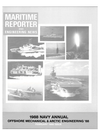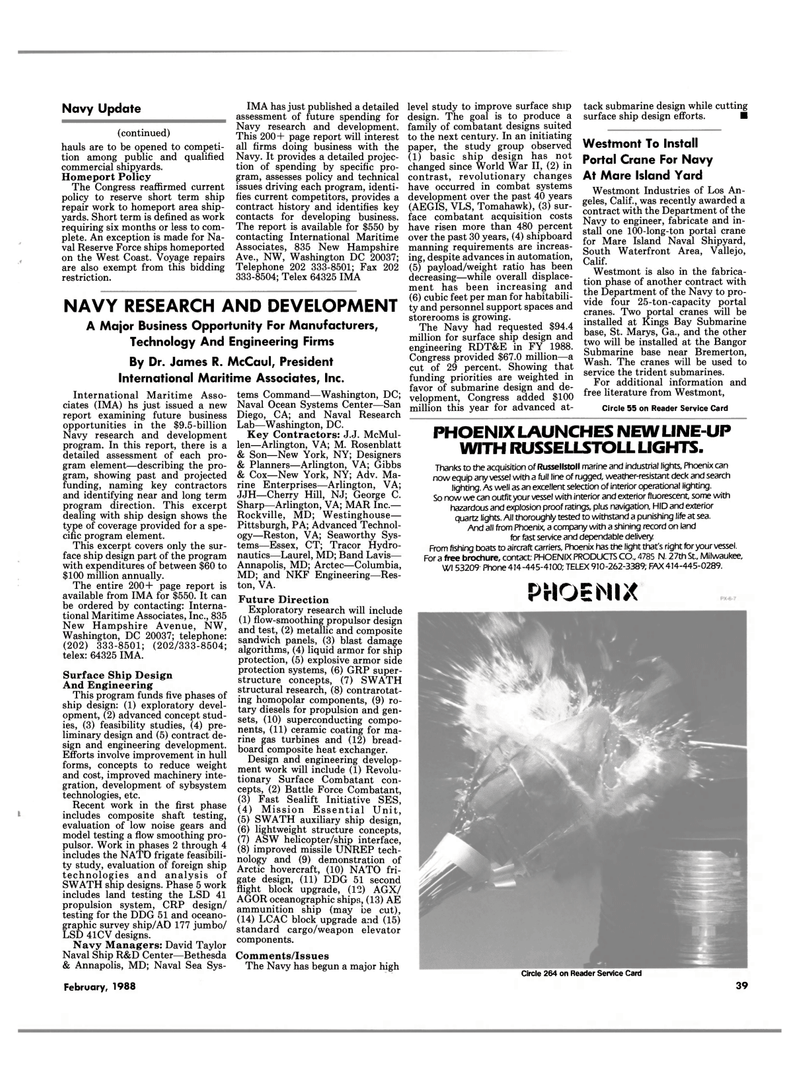
Page 37: of Maritime Reporter Magazine (February 1988)
Read this page in Pdf, Flash or Html5 edition of February 1988 Maritime Reporter Magazine
Navy Update (continued) hauls are to be opened to competi- tion among public and qualified commercial shipyards.
Homeport Policy
The Congress reaffirmed current policy to reserve short term ship repair work to homeport area ship- yards. Short term is defined as work requiring six months or less to com- plete. An exception is made for Na- val Reserve Force ships homeported on the West Coast. Voyage repairs are also exempt from this bidding restriction.
IMA has just published a detailed assessment of future spending for
Navy research and development.
This 200+ page report will interest all firms doing business with the
Navy. It provides a detailed projec- tion of spending by specific pro- gram, assesses policy and technical issues driving each program, identi- fies current competitors, provides a contract history and identifies key contacts for developing business.
The report is available for $550 by contacting International Maritime
Associates, 835 New Hampshire
Ave., NW, Washington DC 20037;
Telephone 202 333-8501; Fax 202 333-8504; Telex 64325 IMA
NAVY RESEARCH AND DEVELOPMENT
A Major Business Opportunity For Manufacturers,
Technology And Engineering Firms
By Dr. James R. McCaul, President
International Maritime Associates, Inc.
International Maritime Asso- ciates (IMA) hs just issued a new report examining future business opportunities in the $9.5-billion
Navy research and development program. In this report, there is a detailed assessment of each pro- gram element—describing the pro- gram, showing past and projected funding, naming key contractors and identifying near and long term program direction. This excerpt dealing with ship design shows the type of coverage provided for a spe- cific program element.
This excerpt covers only the sur- face ship design part of the program with expenditures of between $60 to $100 million annually.
The entire 200+ page report is available from IMA for $550. It can be ordered by contacting: Interna- tional Maritime Associates, Inc., 835
New Hampshire Avenue, NW,
Washington, DC 20037; telephone: (202) 333-8501; (202/333-8504; telex: 64325 IMA.
Surface Ship Design
And Engineering
This program funds five phases of ship design: (1) exploratory devel- opment, (2) advanced concept stud- ies, (3) feasibility studies, (4) pre- liminary design and (5) contract de- sign and engineering development.
Efforts involve improvement in hull forms, concepts to reduce weight and cost, improved machinery inte- gration, development of sybsystem technologies, etc.
Recent work in the first phase includes composite shaft testing, evaluation of low noise gears and model testing a flow smoothing pro- pulsor. Work in phases 2 through 4 includes the NATD frigate feasibili- ty study, evaluation of foreign ship technologies and analysis of
SWATH ship designs. Phase 5 work includes land testing the LSD 41 propulsion system, CRP design/ testing for the DDG 51 and oceano- graphic survey ship/AD 177 jumbo/
LSD 41CV designs.
Navy Managers: David Taylor
Naval Ship R&D Center—Bethesda & Annapolis, MD; Naval Sea Sys-
February, 1988 tems Command—Washington, DC;
Naval Ocean Systems Center—San
Diego, CA; and Naval Research
Lab—Washington, DC.
Key Contractors: J.J. McMul- len—Arlington, VA; M. Rosenblatt & Son—New York, NY; Designers & Planners—Arlington, VA; Gibbs & Cox—New York, NY; Adv. Ma- rine Enterprises—Arlington, VA;
JJH—Cherry Hill, NJ; George C.
Sharp—Arlington, VA; MAR Inc.—
Rockville, MD; Westinghouse—
Pittsburgh, PA; Advanced Technol- ogy—Reston, VA; Seaworthy Sys- tems—Essex, CT; Tracor Hydro- nautics—Laurel, MD; Band Lavis—
Annapolis, MD; Arctec—Columbia,
MD; and NKF Engineering—Res- ton, VA.
Future Direction
Exploratory research will include (1) flow-smoothing propulsor design and test, (2) metallic and composite sandwich panels, (3) blast damage algorithms, (4) liquid armor for ship protection, (5) explosive armor side protection systems, (6) GRP super- structure concepts, (7) SWATH structural research, (8) contrarotat- ing homopolar components, (9) ro- tary diesels for propulsion and gen- sets, (10) superconducting compo- nents, (11) ceramic coating for ma- rine gas turbines and (12) bread- board composite heat exchanger.
Design and engineering develop- ment work will include (1) Revolu- tionary Surface Combatant con- cepts, (2) Battle Force Combatant, (3) Fast Sealift Initiative SES, (4) Mission Essential Unit, (5) SWATH auxiliary ship design, (6) lightweight structure concepts, (7) ASW helicopter/ship interface, (8) improved missile UNREP tech- nology and (9) demonstration of
Arctic hovercraft, (10) NATO fri- gate design, (11) DDG 51 second flight block upgrade, (12) AGX/
AGOR oceanographic ships, (13) AE ammunition ship (may be cut), (14) LCAC block upgrade and (15) standard cargo/weapon elevator components.
Comments/Issues
The Navy has begun a major high level study to improve surface ship design. The goal is to produce a family of combatant designs suited to the next century. In an initiating paper, the study group observed (1) basic ship design has not changed since World War II, (2) in contrast, revolutionary changes have occurred in combat systems development over the past 40 years (AEGIS, VLS, Tomahawk), (3) sur- face combatant acquisition costs have risen more than 480 percent over the past 30 years, (4) shipboard manning requirements are increas- ing, despite advances in automation, (5) payload/weight ratio has been decreasing—while overall displace- ment has been increasing and (6) cubic feet per man for habitabili- ty and personnel support spaces and storerooms is growing.
The Navy had requested $94.4 million for surface ship design and engineering RDT&E in FY 1988.
Congress provided $67.0 million—a cut of 29 percent. Showing that funding priorities are weighted in favor of submarine design and de- velopment, Congress added $100 million this year for advanced at- tack submarine design while cutting surface ship design efforts. •
Westmont To Install
Portal Crane For Navy
At Mare Island Yard
Westmont Industries of Los An- geles, Calif., was recently awarded a contract with the Department of the
Navy to engineer, fabricate and in- stall one 100-long-ton portal crane for Mare Island Naval Shipyard,
South Waterfront Area, Vallejo,
Calif.
Westmont is also in the fabrica- tion phase of another contract with the Department of the Navy to pro- vide four 25-ton-capacity portal cranes. Two portal cranes will be installed at Kings Bay Submarine base, St. Marys, Ga., and the other two will be installed at the Bangor
Submarine base near Bremerton,
Wash. The cranes will be used to service the trident submarines.
For additional information and free literature from Westmont,
Circle 55 on Reader Service Card
PHOENIX LAUNCHES NEW LINE-UP
WITH RUSSELLSTOLL LIGHTS.
Thanks to the acquisition of Russellstoll marine and industrial lights. Phoenix can now equip any vessel with a full line of rugged, weather-resistant deck and search lighting. As well as an excellent selection of interior operational lighting.
So now we can outfit your vessel with interior and exterior fluorescent, some with hazardous and explosion proof ratings, plus navigation, HID and exterior quartz lights. All thoroughly tested to withstand a punishing life at sea.
And all from Phoenix, a company with a shining record on land for fast service and dependable deliveiy
From fishing boats to aircraft carriers, Phoenix has the light that's right for your vessel.
For a free brochure, contact: PHOENIX PRODUCTS CO., 4785 N. 27th St., Milwaukee,
Wl 53209- Phone 414-445-4100; TELEX 910-262-3389; FAX 414-445-0289.
PHOSNliC
Circle 264 on Reader Service Card 39

 36
36

 38
38
